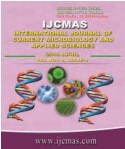


 National Academy of Agricultural Sciences (NAAS)
National Academy of Agricultural Sciences (NAAS)

|
PRINT ISSN : 2319-7692
Online ISSN : 2319-7706 Issues : 12 per year Publisher : Excellent Publishers Email : editorijcmas@gmail.com / submit@ijcmas.com Editor-in-chief: Dr.M.Prakash Index Copernicus ICV 2018: 95.39 NAAS RATING 2020: 5.38 |
A field experiment was conducted during the kharif season of 2016 and 2017 in the Research farm of College of Agriculture, Central Agricultural University, Imphal in order to study the effect of different weed and nutrient management practices on the growth and yield of kharif rice. The experiment was laid out in factorial randomized design (FRBD) replicated thrice. The treatments comprised of five levels of weed management practices and three levels of nutrient management practices. The pooled data revealed that among the weed management practices, application of Pyrazosulfuron ethyl (PE) + Hand weeding (HW) at 40 DAS (W2) gave the highest plant growth attributes like plant height, number of tillers per m2, leaf area index at all the growth stages of kharif rice and highest grain yield of 48.34 q ha-1 and straw yield of 68.15 q ha-1 but it was significantly at par with Pyrazosulfuron ethyl (PE) + Mechanical weeding (MW) at 40 DAS (W3). Among the nutrient management practices, highest grain yield of 43.17 q ha-1 was obtained with the application of 50% RDF+ 6t FYM (N1) followed by the application of 50% RDF+ Azolla (dual crop)@10t/ha + 3t FYM (N2). The interaction between the different weed and nutrient management practices had no significant effect on the growth attributes and yield of kharif rice.
 |
 |
 |
 |
 |